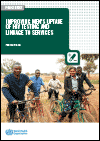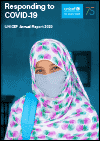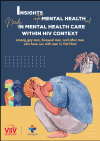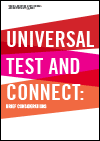What's New
Displaying results 421 - 430 of 4913

Resource | Publications,
The World Health Organization (WHO) has published a global TB report every year since 1997. The purpose of the report is to provide a comprehensive and up-to-date assessment of the status of the TB epidemic and progress in the response at global, regional and national levels, in the context of global commitments, strategies and targets.
The 2020 report included a provisional assessment of the impact of the COVID-19 pandemic on TB services, TB disease burden and progress towards targets. This 2021 edition provides updated, more definitive and more wide-ranging results.

Resource | Publications,
In 2015, to advance the global and national response to antimicrobial resistance (AMR), the World Health Assembly issued resolution WHA68.7 calling for all Member States to develop AMR national action plans that address the five objectives of the World Health Organization Global Action Plan (GAP) by May 2017. The WHO GAP provides a framework to support countries in developing their national action plans on AMR. To operationalize and accelerate implementation of national action plans on AMR, WHO has developed a costing and budgeting tool and accompanying user guide. The purpose is to support countries in costing prioritized activities of an operational plan linked to their AMR national action plan, and identify existing funding and funding gaps to promote resource mobilization and sustainable implementation. The target audience of the publication are national policy makers and designated costing coordinators for national action plans on AMR.

Resource | Publications,
In 2019 an estimated 7.2 million people, 19% of all those with HIV, were undiagnosed. Men in high HIV burden settings and men from key populations are consistently less likely to know their HIV status than women. WHO recommends a strategic mix of differentiated HIV testing services (HTS) approaches to reach men and link them to appropriate prevention and treatment services.
This policy brief highlights WHO-recommended HTS approaches that programmes can introduce or scale up now to optimize the uptake of HTS among men. The brief also summarizes a package of post-test services for men. HTS can link men to these services as appropriate for their test results.

Resource | Fact Sheets,
In August 2021, there was 878 confirmed HIV-positive individuals reported to HIV/AIDS & ART registry of the Philippines (HARP) and were accounted to the total (90,031) reported cases since January 1984. Moreover, 13% (110) of individuals reported in August had clinical manifestations of advanced HIV infection at the time of testing.
Ninety-six percent (847) of the reported cases were male. Of the total male cases, 2% (21) reported their gender-identity as female (transgender women) at the time of testing.

Resource | Publications,
UNICEF’s 2020 Annual Report underscores how 2020 was a year like no other. School closures, increased vulnerability to abuse, mental health strains and loss of access to vital services have hurt children deeply. But not all children have been affected equally. The pandemic has exposed deep inequalities that have existed for too long, with the worst consequences on children in the poorest countries and communities and those already disadvantaged.

Resource | Publications,
The COVID-19 pandemic has raised concerns about the mental health of a generation of children. But the pandemic may represent the tip of a mental health iceberg – an iceberg we have ignored for far too long. The State of the World’s Children 2021 examines child, adolescent and caregiver mental health. It focuses on risks and protective factors at critical moments in the life course and delves into the social determinants that shape mental health and well-being.

Resource | Publications,
An overview of MSM's mental health research shows that the number of publications on this issue in Vietnam is limited. Meanwhile, recent international research shows that mental health and its relationship with other factors are outstanding topics that many researchers are concerned about. In the limit of time and resources, the research focuses on the specific mental health aspects and three related factors, including social support, self-stigma, and sexual behavior. On that basis, the research suggests potential psychosocial interventions to improve mental health, reduce HIV risky sexual behaviors, and increase access to health services in the Vietnamese MSM community.

Resource | Publications,
Universal test and connect (UTC) is an intensive community-wide strategy to accelerate HIV epidemic transition in order to rapidly reduce new HIV infections and deaths from AIDS-related illnesses within a specific community. It is an additional, complementary strategy focused on specific communities or subnational areas, with the aim of ensuring rapid impact. UTC relies on a variety of community-based, people-centred approaches to reach people outside of healthcare facilities, connect them to quality, respectful and non-stigmatizing HIV services and transform community acceptance and engagement for HIV and health.

Resource | Publications,
Violence against women (VAW) is a major public health concern, a manifestation of gender inequality and a human rights violation. Intimate partner violence1 is the most common form of violence experienced by women. Violence has significant and long-lasting impacts on women’s physical health, including sexual, reproductive and mental health. Women who have experienced violence are more likely to seek health care than non-abused women. Health-care providers (HCPs) are well-placed to identify women who have experienced violence and to provide appropriate clinical care and referrals.

Resource | Publications,
The pandemic has tested and even reversed progress in expanding women’s rights and opportunities. “Progress on the Sustainable Development Goals: The gender snapshot 2021” presents the latest evidence on gender equality across all 17 Goals, highlighting the progress made since 2015 but also the continued alarm over the COVID-19 pandemic, its immediate effect on women’s well-being, and the threat it poses to future generations.





